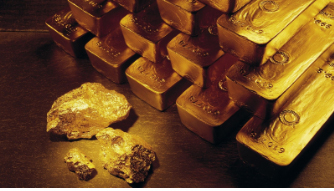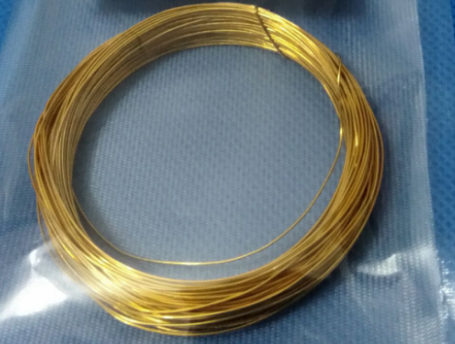Gold
Gold is a mineral that is a natural solid solution of
silver (traces, up to 43%) in gold; common impurities (traces, up to
0.9%) of copper, iron, lead, less often - bismuth, mercury, platinum,
manganese, etc. There are varieties with an increased copper content -
up to 20% (cuprous gold, cuproaurite), bismuth - up to 4 % (bismuth
gold, bismuthaurite), platinoids (platinum and iridous gold; porpecite -
Au, Pd, give birth - Au, Rh), natural amalgams (Au, Hg).
It crystallizes in a cubic system, in the form of octahedra,
rhombododecahedrons, cubes and more complex crystals; often they are
distorted, strongly elongated, forming "wires", "hairs", or flattened
parallel to the face of the octahedron. Native gold is especially
low-grade, characterized by a variety of growth forms, it is usually in
the form of skeletal crystals, dendrites, whiskers and twisted-whiskers.
Vein-like and irregular lumpy, "hooked" discharge is widespread; on
their surface, imprints of crystals of other minerals are often
preserved, the aggregates of which included accumulations of native
gold. Etching reveals the crystalline-granular structure of the gold
particles.
Gold is a very heavy metal: the density of pure gold is 19.32 g / cm^3 (a
ball of pure gold with a diameter of 46.237 mm has a mass of 1 kg).
Diamagnetic, that is, the magnetic field in gold is weakened. Among
metals, it occupies seventh place in density after osmium, iridium,
rhenium, platinum, neptunium and plutonium. Tungsten has a density
comparable to that of gold (19.25). The high density of gold makes it
easier to mine, which is why even simple technological processes - for
example, washing at sluices - can provide a high degree of gold recovery
from the washed rock.
Gold is a very soft metal: hardness according to the Mohs scale is ~
2.5, according to Brinell 220-250 MPa (comparable to the hardness of a
nail).
Gold is also highly plastic: it can be forged into sheets up to ~ 0.1
microns (100 nm) thick (gold leaf); with such a thickness, gold is
translucent and in reflected light has a yellow color, in transmitted
light it is colored bluish-greenish, complementary to yellow. Gold can
be drawn into wire with a linear density of up to 2 mg / m.
The melting point of gold is 1064.18 ° C (1337.33 K), boils at 2856 ° C
(3129 K). The density of liquid gold is less than that of solid gold,
and amounts to 17 g / cm3 at the melting point. Liquid gold is quite
volatile, and actively evaporates long before its boiling point.
The gold content in the earth's crust is very low - 4.3 o 10-10% by
weight (0.5-5 mg / t), but deposits and areas sharply enriched in metal
are very numerous. Gold is also found in water. One liter of both sea
and river water contains less than 5 o 10-9 grams of Au, which roughly
corresponds to 5 kilograms of gold in 1 cubic kilometer of water.
Gold deposits occur mainly in areas of development of granitoids, a
small number of them are associated with basic and ultrabasic rocks.
To obtain gold, its basic physical and chemical properties are used:
presence in nature in a native state, the ability to react with only a
few substances (mercury, cyanides). With the development of modern
technologies, chemical methods are becoming more popular.
In terms of its chemical resistance and mechanical strength, gold is
inferior to most platinoids, but it is irreplaceable as a material for
electrical contacts. Therefore, in microelectronics, gold conductors and
gold electroplating of contact surfaces, connectors, printed circuit
boards are used very widely.
Gold is used as a target in nuclear research, as a coating for mirrors
operating in the far infrared range, as a special shell in a neutron
bomb. A thin layer of gold (20 nm) on the inner surface of window and
stained glass significantly reduces unwanted heat losses in winter and
protects the interior of buildings and vehicles from infrared heating in
summer.
Gold solders are very good at wetting various metal surfaces and are
used for soldering metals. Thin gaskets made of soft gold alloys are
used in the ultra-high vacuum technique.
The traditional and largest consumer of gold is the jewelry industry.
Jewelry is made not of pure gold, but of its alloys with other metals,
significantly superior to gold in terms of mechanical strength and
durability. Currently, Au-Ag-Cu alloys are used for this, which may
contain additives of zinc, nickel, cobalt, palladium. The corrosion
resistance of such alloys is determined mainly by the gold content in
them, and the color shades and mechanical properties are determined by
the ratio of silver and copper.
Dentistry consumes significant amounts of gold: crowns and dentures are
made from alloys of gold with silver, copper, nickel, platinum, zinc.
These alloys combine corrosion resistance with high mechanical
properties.
Gold compounds are part of some medicines used to treat a number of
diseases (tuberculosis, rheumatoid arthritis, etc.). The radioactive
isotope 198Au (half-life 2.967 days) is used in the treatment of
malignant tumors in radiotherapy.
.


Gold is a mineral that is a natural solid solution of
silver (traces, up to 43%) in gold; common impurities (traces, up to
0.9%) of copper, iron, lead, less often - bismuth, mercury, platinum,
manganese, etc. There are varieties with an increased copper content -
up to 20% (cuprous gold, cuproaurite), bismuth - up to 4 % (bismuth
gold, bismuthaurite), platinoids (platinum and iridous gold; porpecite -
Au, Pd, give birth - Au, Rh), natural amalgams (Au, Hg).
It crystallizes in a cubic system, in the form of octahedra,
rhombododecahedrons, cubes and more complex crystals; often they are
distorted, strongly elongated, forming "wires", "hairs", or flattened
parallel to the face of the octahedron. Native gold is especially
low-grade, characterized by a variety of growth forms, it is usually in
the form of skeletal crystals, dendrites, whiskers and twisted-whiskers.
Vein-like and irregular lumpy, "hooked" discharge is widespread; on
their surface, imprints of crystals of other minerals are often
preserved, the aggregates of which included accumulations of native
gold. Etching reveals the crystalline-granular structure of the gold
particles.
Gold is a very heavy metal: the density of pure gold is 19.32 g / cm^3 (a
ball of pure gold with a diameter of 46.237 mm has a mass of 1 kg).
Diamagnetic, that is, the magnetic field in gold is weakened. Among
metals, it occupies seventh place in density after osmium, iridium,
rhenium, platinum, neptunium and plutonium. Tungsten has a density
comparable to that of gold (19.25). The high density of gold makes it
easier to mine, which is why even simple technological processes - for
example, washing at sluices - can provide a high degree of gold recovery
from the washed rock.
Gold is a very soft metal: hardness according to the Mohs scale is ~
2.5, according to Brinell 220-250 MPa (comparable to the hardness of a
nail).
Gold is also highly plastic: it can be forged into sheets up to ~ 0.1
microns (100 nm) thick (gold leaf); with such a thickness, gold is
translucent and in reflected light has a yellow color, in transmitted
light it is colored bluish-greenish, complementary to yellow. Gold can
be drawn into wire with a linear density of up to 2 mg / m.
The melting point of gold is 1064.18 ° C (1337.33 K), boils at 2856 ° C
(3129 K). The density of liquid gold is less than that of solid gold,
and amounts to 17 g / cm3 at the melting point. Liquid gold is quite
volatile, and actively evaporates long before its boiling point.
The gold content in the earth's crust is very low - 4.3 o 10-10% by
weight (0.5-5 mg / t), but deposits and areas sharply enriched in metal
are very numerous. Gold is also found in water. One liter of both sea
and river water contains less than 5 o 10-9 grams of Au, which roughly
corresponds to 5 kilograms of gold in 1 cubic kilometer of water.
Gold deposits occur mainly in areas of development of granitoids, a
small number of them are associated with basic and ultrabasic rocks.
To obtain gold, its basic physical and chemical properties are used:
presence in nature in a native state, the ability to react with only a
few substances (mercury, cyanides). With the development of modern
technologies, chemical methods are becoming more popular.
In terms of its chemical resistance and mechanical strength, gold is
inferior to most platinoids, but it is irreplaceable as a material for
electrical contacts. Therefore, in microelectronics, gold conductors and
gold electroplating of contact surfaces, connectors, printed circuit
boards are used very widely.
Gold is used as a target in nuclear research, as a coating for mirrors
operating in the far infrared range, as a special shell in a neutron
bomb. A thin layer of gold (20 nm) on the inner surface of window and
stained glass significantly reduces unwanted heat losses in winter and
protects the interior of buildings and vehicles from infrared heating in
summer.
Gold solders are very good at wetting various metal surfaces and are
used for soldering metals. Thin gaskets made of soft gold alloys are
used in the ultra-high vacuum technique.
The traditional and largest consumer of gold is the jewelry industry.
Jewelry is made not of pure gold, but of its alloys with other metals,
significantly superior to gold in terms of mechanical strength and
durability. Currently, Au-Ag-Cu alloys are used for this, which may
contain additives of zinc, nickel, cobalt, palladium. The corrosion
resistance of such alloys is determined mainly by the gold content in
them, and the color shades and mechanical properties are determined by
the ratio of silver and copper.
Dentistry consumes significant amounts of gold: crowns and dentures are
made from alloys of gold with silver, copper, nickel, platinum, zinc.
These alloys combine corrosion resistance with high mechanical
properties.
Gold compounds are part of some medicines used to treat a number of
diseases (tuberculosis, rheumatoid arthritis, etc.). The radioactive
isotope 198Au (half-life 2.967 days) is used in the treatment of
malignant tumors in radiotherapy.
.

|

|
